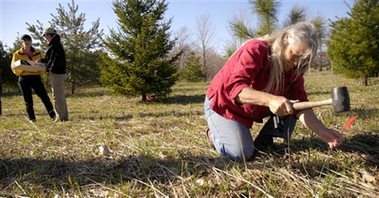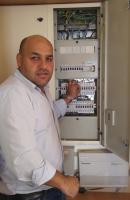‘Green’ burials growing in popularity
 (Associated Press) It sits on the eastern fringe of New York’s Finger Lakes region and is bounded on three sides by 8,000 acres of protected forests: the perfectly natural place to spend an eternity. The 93-acre Greensprings Natural Cemetery is the first of its kind in New York and one of just a handful in the United States, where interest in “green” burial is just taking root. Carl Leopold, a retired Cornell University plant scientist, bought one of the first 20 plots sold. “It’s so sensible,” he said. “Putting bodies in a waterproof, permanent container protected from the environment, it’s ridiculous.”
(Associated Press) It sits on the eastern fringe of New York’s Finger Lakes region and is bounded on three sides by 8,000 acres of protected forests: the perfectly natural place to spend an eternity. The 93-acre Greensprings Natural Cemetery is the first of its kind in New York and one of just a handful in the United States, where interest in “green” burial is just taking root. Carl Leopold, a retired Cornell University plant scientist, bought one of the first 20 plots sold. “It’s so sensible,” he said. “Putting bodies in a waterproof, permanent container protected from the environment, it’s ridiculous.”
Mystech: Ok, I know this seems to be becoming an obsession with me, but I promise it’s not some cry for help. I’m legitimately fascinated by alternatives to being pumped full of (more) chemicals and buried in a hermetically sealed tube under a modern day pyramid.
At Greensprings, where a plot costs $500 plus a $350 fee to dig the grave, bodies cannot be embalmed or otherwise chemically preserved. They must be buried in biodegradable caskets without linings or metal ornamentation. The cemetery suggests locally harvested woods, wicker or cloth shrouds. Concrete or steel burial vaults are not allowed. Nor are standing monuments, upright tombstones or statues.
Only flat, natural fieldstones are permitted as grave markers (they can be engraved). Shrubs or trees are preferred.
And only one person is allowed in each 15-foot-by-15-foot plot.

“This is more than just dig a hole in the woods and roll them in. We see it as a natural return to the Earth, becoming part of the circle of life,” said Mary Woodsen, a lifelong conservationist and the cemetery’s president.
“Not everyone will find this appealing,” she said. “But there are people who want that look and feel of nature.”
Natural or woodland cemeteries are common in the United Kingdom, where they make up more than 10 percent of burials. In the United States, however, green burial is a relatively new idea, but one that has caught the attention of people who favor blending land conservation with a natural approach to funerals.
Thirty-two-acre Ramsey Creek Preserve, which opened in 1998 in rural Westminster, S.C., is acknowledged as the nation’s first green cemetery. Others are in Florida, Texas, California and Washington state.
Elizabeth Stuckman, 47, made arrangements to be buried at Ramsey Creek, which was started by family physician and environmentalist Billy Campbell, who was looking to simplify the increasingly involved funeral process and help conserve land. Stuckman had her brother’s ashes spread there after he was killed in a car accident last fall. Her parents have plans to be buried there, too.
“There’s life in the land. It’s not a dead place like a conventional cemetery. It’s intensely alive, and that’s what you focus on,” Stuckman said.
At her brother’s funeral, the children were able to play in a nearby stream, while his friends picnicked and performed bluegrass music.
“I like that the land is wild and always changing with time,” she said. “Whether we like it or not, death is about change. To pretend my brother is just sleeping under a mowed and manicured lawn is to deny that death is about change.”
Today, there are 70 people interred at Ramsey Creek, said Campbell’s wife, Kimberley, who is vice president of Memorial Ecosystems, which runs the cemetery.
“We’ve seen growth in the hospice movement,” she said. “We’ve seen an upswing of home birthing. People are interested in returning to the simple ways. This is just a dust-to-dust approach to funerals.”
Robert Fells, a spokesman for the Virginia-based International Cemetery and Funeral Association, said the green concept is just a repackaging of what the conventional cemetery burial already offers.
Contrary to widespread belief, embalming is not required by law so people can refuse it, Fells said. Buy a no-frills wooden coffin. Plant a bush instead of a gravestone. Those options are currently available at most cemeteries, he said.
According to the Federal Trade Commission, the average funeral in the United States costs about $6,000. Many exceed $10,000. Even cremation typically costs more than $1,000 — and has its environmental downside: Cremation uses energy and releases dioxin and mercury (up to 6 grams a body) while preventing nutrients in bodies from enriching the land.
Josh Slocum, of the Funeral Consumers Alliance, a Burlington, Vt.-based federation of advocacy groups, said natural cemeteries provide “another choice for consumers, and that’s always good.”
“Most of what we think of today as the traditional funeral — embalming, expensive caskets, manicured cemeteries — are practices started in the 20th century when burying the dead became an industry,” he said. “This is really nothing new. It’s what the pilgrims and the pioneers did … Really natural burial is as old as death itself.”
The Greensprings preserve, located 75 miles southwest of Syracuse, was once mostly pasture and cropland before it was acquired from a conservation-minded seller.
“Someday, we’d like to see most of the property return to the native woodlands that used to be here,” said Woodsen.
Eventually, trails will wind through meadows, woods and burial areas.




















